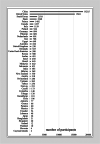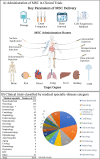A Brief Overview of Global Trends in MSC-Based Cell Therapy
- PMID: 35344199
- PMCID: PMC8958818
- DOI: 10.1007/s12015-022-10369-1
A Brief Overview of Global Trends in MSC-Based Cell Therapy
Abstract
Human mesenchymal stem cells (MSCs), also known as mesenchymal stromal cells or medicinal signaling cells, are important adult stem cells for regenerative medicine, largely due to their regenerative characteristics such as self-renewal, secretion of trophic factors, and the capability of inducing mesenchymal cell lineages. MSCs also possess homing and trophic properties modulating immune system, influencing microenvironment around damaged tissues and enhancing tissue repair, thus offering a broad perspective in cell-based therapies. Therefore, it is not surprising that MSCs have been the broadly used adult stem cells in clinical trials. To gain better insights into the current applications of MSCs in clinical applications, we perform a comprehensive review of reported data of MSCs clinical trials conducted globally. We summarize the biological effects and mechanisms of action of MSCs, elucidating recent clinical trials phases and findings, highlighting therapeutic effects of MSCs in several representative diseases, including neurological, musculoskeletal diseases and most recent Coronavirus infectious disease. Finally, we also highlight the challenges faced by many clinical trials and propose potential solutions to streamline the use of MSCs in routine clinical applications and regenerative medicine.
Keywords: Gene and Stem Cell Therapy; Personalized Medicine; Precision Medicine; Regenerative Medicine; Stem Cell Therapy; iPSC.
© 2022. The Author(s), under exclusive licence to Springer Science+Business Media, LLC, part of Springer Nature.
Conflict of interest statement
Authors declare no conflict of interest.
Figures





Similar articles
-
Towards Personalized Regenerative Cell Therapy: Mesenchymal Stem Cells Derived from Human Induced Pluripotent Stem Cells.Curr Stem Cell Res Ther. 2016;11(2):122-30. doi: 10.2174/1574888x10666150723150236. Curr Stem Cell Res Ther. 2016. PMID: 26201862
-
Secreted trophic factors of mesenchymal stem cells support neurovascular and musculoskeletal therapies.Stem Cell Res Ther. 2016 Sep 9;7(1):131. doi: 10.1186/s13287-016-0394-0. Stem Cell Res Ther. 2016. PMID: 27612948 Free PMC article. Review.
-
Concise Review: Multifaceted Characterization of Human Mesenchymal Stem Cells for Use in Regenerative Medicine.Stem Cells Transl Med. 2017 Dec;6(12):2173-2185. doi: 10.1002/sctm.17-0129. Epub 2017 Oct 26. Stem Cells Transl Med. 2017. PMID: 29076267 Free PMC article. Review.
-
Mesenchymal Stem Cells in Veterinary Regenerative Therapy: Basic Physiology and Clinical Applications.Curr Stem Cell Res Ther. 2022;17(3):237-251. doi: 10.2174/1574888X16666210804112741. Curr Stem Cell Res Ther. 2022. PMID: 34348630
-
Characterization and therapeutic applications of mesenchymal stem cells for regenerative medicine.Tissue Cell. 2020 Jun;64:101330. doi: 10.1016/j.tice.2020.101330. Epub 2020 Jan 10. Tissue Cell. 2020. PMID: 32473704 Review.
Cited by
-
Mesenchymal Stem Cell Priming: Potential Benefits of Administration of Molecular Hydrogen.Pharmaceuticals (Basel). 2024 Apr 7;17(4):469. doi: 10.3390/ph17040469. Pharmaceuticals (Basel). 2024. PMID: 38675429 Free PMC article. Review.
-
Effects of adipose-derived cell supplementation on tendon-bone healing in a rat model of chronic rotator cuff tear with suprascapular nerve injury.J Int Med Res. 2024 Mar;52(3):3000605241232550. doi: 10.1177/03000605241232550. J Int Med Res. 2024. PMID: 38456645 Free PMC article.
-
Advancing cell-based therapy in sepsis: An anesthesia outlook.Chin Med J (Engl). 2024 Jul 5;137(13):1522-1534. doi: 10.1097/CM9.0000000000003097. Epub 2024 May 6. Chin Med J (Engl). 2024. PMID: 38708689 Free PMC article. Review.
-
Single-cell Technology in Stem Cell Research.Curr Stem Cell Res Ther. 2025;20(1):9-32. doi: 10.2174/011574888X265479231127065541. Curr Stem Cell Res Ther. 2025. PMID: 38243989 Review.
-
Evaluation of the Efficacy of Stem Cells Therapy in the Periodontal Regeneration: A Meta-Analysis and Mendelian Randomization Study.Stem Cell Rev Rep. 2024 May;20(4):980-995. doi: 10.1007/s12015-024-10690-x. Epub 2024 Feb 22. Stem Cell Rev Rep. 2024. PMID: 38388709 Review.
References
Publication types
MeSH terms
LinkOut - more resources
Full Text Sources

